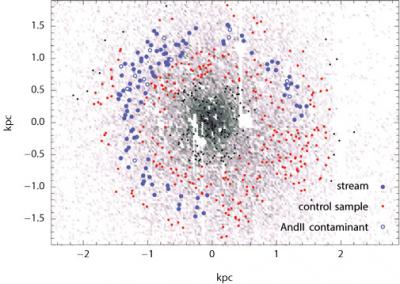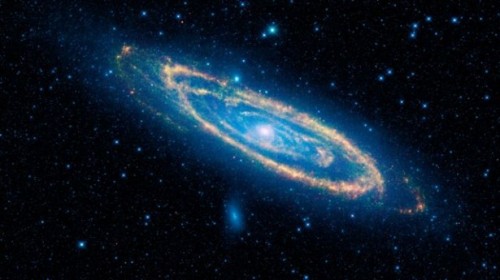The dwarf galaxy Andromeda 2, one of the satellite galaxies of the nearby giant galaxy Andromeda, appears to be a merger of two tiny galaxies, something that was not widely accepted as possible and has not been observed until now

Like the Milky Way, the nearby Andromeda Galaxy is surrounded by a swarm of small satellite galaxies. Researchers from the Niels Bohr Institute and other universities discovered a stream of stars moving in the coordinate of stars from one of the outer satellite galaxies of Andromeda, this dwarf galaxy is called Andromeda 2 (Andromeda II). The movement of the stars in the stream indicates that what we are seeing is a merger between two dwarf galaxies. A merger between galaxies of such low mass has not been observed so far. The research was published in the journal Nature.
The galaxies in the early universe started out small, and according to the theory, the baby galaxies slowly grew to become massive through the merger of two small galaxies to form a larger galaxy. These large galaxies keep pulling smaller galaxies towards them due to their gravity and eventually they merge into it and the galaxy grows even bigger.
However, it turns out that not all small galaxies are "eaten" by large galaxies. A few of them remained in orbit around the great galaxy. The largest galaxy in our cosmic environment is the Andromeda Galaxy, which is about 2.3 million light years away from us. Like our home galaxy, the Milky Way, Andromeda is a large spiral galaxy.

A swarm of small galaxies
Andromeda is surrounded by a swarm of small galaxies - astronomers have counted more than 20 so far. For convenience, they have been given numbered names (Andromeda 1,2, etc.). Researchers from the Center for Dark Cosmology at the Niels Bohr Institute in Denmark and their research partners, analyzed the observational measurements from the dwarf galaxy Andromeda 2 and discovered what they say is a surprising discovery.
Image: The Andromeda Galaxy is a large spiral galaxy similar to the Milky Way. It is 2.3 million light years away and can be seen with the naked eye.
Stars in the dwarf galaxy sometimes move randomly, but this is not the case for Andromeda 2. In particular, we can see that a stream of stars is consistently moving in the opposite direction to the rest of the stars. The stars are located in an almost perfect ring and surround the center of the galaxy. ” explains astrophysicist Nicola Amorisco from the Center for Dark Cosmology at the Niels Bohr Institute at the University of Copenhagen.
Cosmic collisions
The dwarf galaxy Andromeda 2 is very small, less than one percent of the size of the Milky Way galaxy. The stream of stars surrounding the galaxy is composed entirely of old stars and according to their properties the researchers were able to reach a conclusion about the dramatic cosmic event.
"What we see is the remnants of a collision between two dwarf galaxies, which has a dramatic effect on the dynamics of the remnants," Amorisco said. He explains that the merger between such small galaxies was expected to take place at the time when the galaxies were formed, and not to survive to the present day, which is the reason for their rarity. Andromeda 2 is the lightest example of a galaxy merger to date, and it demonstrates the scale-free nature of galaxy formation down to the smallest galactic scale.

3 תגובות
Someone, this is not an advertisement this is a social chat component. I will contact them
Don't be misunderstood, the mechanism of the chat itself is welcome, but it is annoying and disturbing that it constantly hovers over the page and hides part of the text (and also does not allow clicking on links/buttons that are above in a vertical line), it would be nice if this option could be opened From a permanent link that does not hover over the page as long as it is not activated.
Avi Blizovsky Hello, the new advertisement (?) that appears on the lower right is really annoying, and it also interferes while writing a message (it is not possible to place the text marker on the one that is above it in a vertical line) I would be happy if this annoying thing would fly away (advertisements that regularly hover over this page One of the most annoying things, it really doesn't fit here) You can put a link that doesn't get in the way at the top of the page (it regularly hides part of the text on the page... it's really annoying)
Now I noticed that it also doesn't allow clicking on the "add comment" button... trying to use tab to get to the button, we'll see if that works...